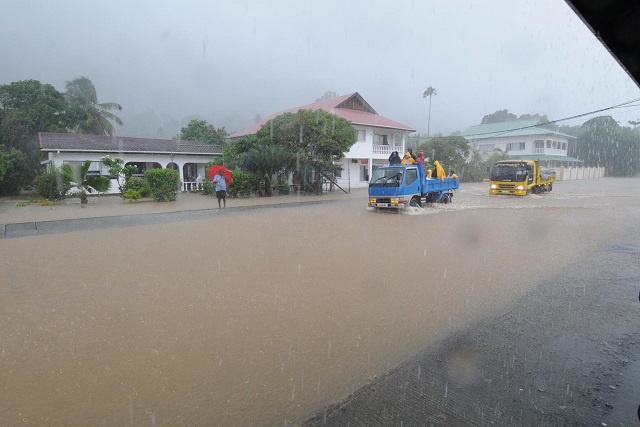Towards a better management of waste water: Seychelles intensifies plan for a Sanitation master plan

Flooding at Pointe Larue on the eastern coast of Mahe in February, 2013. (Joena Bonnelame, Seychelles News Agency)
(Seychelles News Agency) - Seychelles, an Indian Ocean archipelago of 115 island with a population of around 90,000 people is taking steps to ensure further protection of its environment.
The archipelago’s Public Utilities Company (PUC) is aiming for a 'sanitation master plan' in the coming years to ensure proper waste water management across the three main populated islands of Mahé, Praslin and La Digue.
Currently the island nation has three central sewage treatment system which cover homes and other buildings in the capital of Victoria, Beau Vallon in the northern region of the main island of Mahé and part of Mahé’s east coast.
Presently, the coverage is limited to mostly low-lying areas of less than 200 metres high.
In an interview with SNA, the Chief Executive Officer of PUC, Philip Morin said the company has seen the need to fast-track a solution for Mahé’s east coast, which stretches from the International Airport at Pointe Larue up to Pointe Au Sel, about 5 kilometres to the south.
The particular region often face difficulties when there is heavy rainfall or flooding due to the fact that the water table [level below which the ground is completely saturated with water] is high, only around 50 centimetres below the ground. This means septic tanks and soakaways often malfunction during periods of heavy rains.
This was evident early 2013, when widespread flooding and mudslides due to heavy rainfall caused significant damage in east Mahé, resulting in the need to rebuild several houses and infrastructure.
"This is a matter of urgency and must it be dealt with separately as soon as possible. We cannot wait for the master plan," Morin told SNA.
He noted that PUC is awaiting the conclusion of a feasibility and design which is expected to be completed this month and that the company will soon be seeking funding for the project.
The upgrading of the east Mahé sewage treatment system will involve the laying of new pipes or drains, collection points, pumping stations and treatment plant.
PUC's Deputy CEO, Joel Valmont said the second phase of the east Mahé sewage system will bring the number of premises connected to a central system to about 5,500 more than doubling the current figure.
While presently only premises in low-lying areas can be connected to the central sewage systems the sanitation master plan is aiming to include premises found on more elevated grounds.
The east Mahé sewage system plant which is expected to replace an existing one at Pointe Larue was recently presented to residents of the region to have their input before the details are finalized.
"The response was positive and most of those present wanted to know how soon the project will start," said Morin.
The residents were nevertheless concerned about the amount of waste water that will discharge into the marsh from the treatment plant.
According to Morin, the new treatment plant will be designed in a way that waste water can be recycled adding that as such waste water shall not cause any overflowing of the marsh.
Morin said the concept of waste from sewerage treatment plans will change with the launching of the sanitation master plan, which is expected to be funded by the African Water Facility (AWF) of the African Development Bank (AfDB).
"In the past, the approach towards sewage was that it’s a waste that we need to get rid of. In the future, we shall look upon it as a resource since waste water coming from treatment plants will be considered good and clean enough for irrigation and construction," said Morin
He also added that there are also plans to extract methane for use as an alternative energy source.





